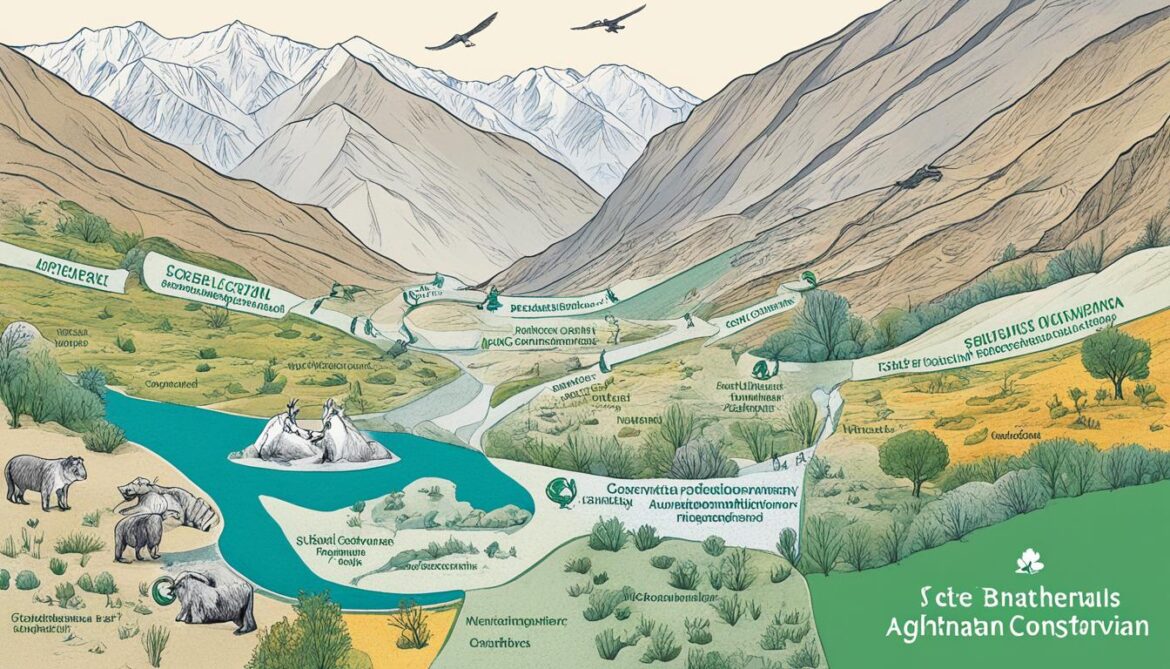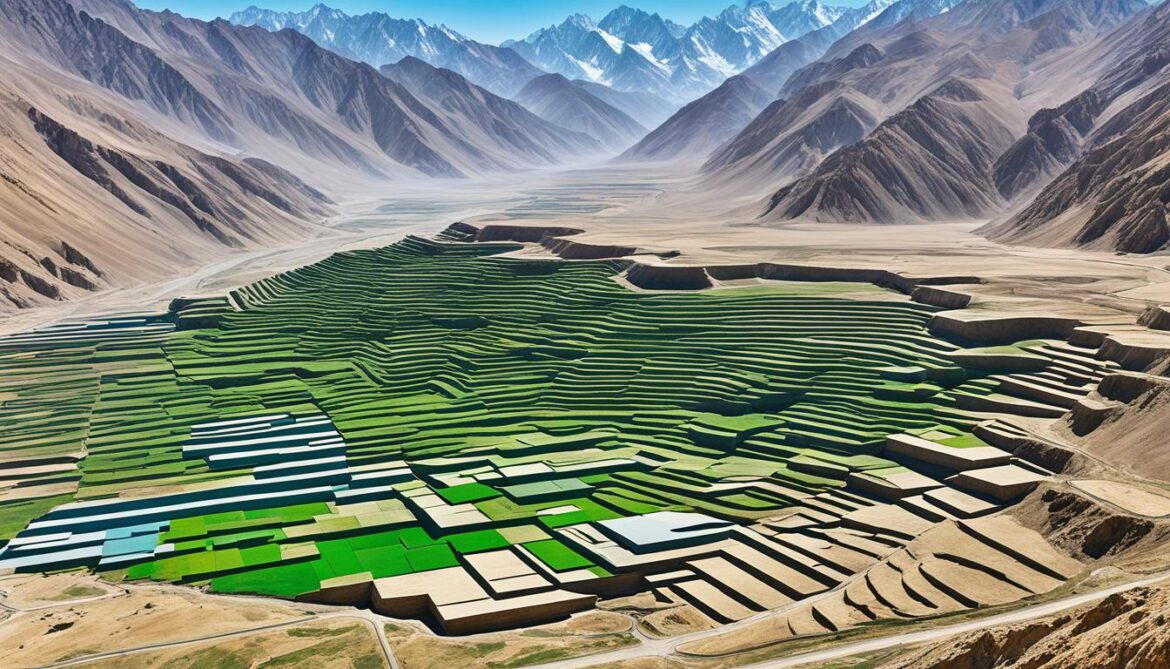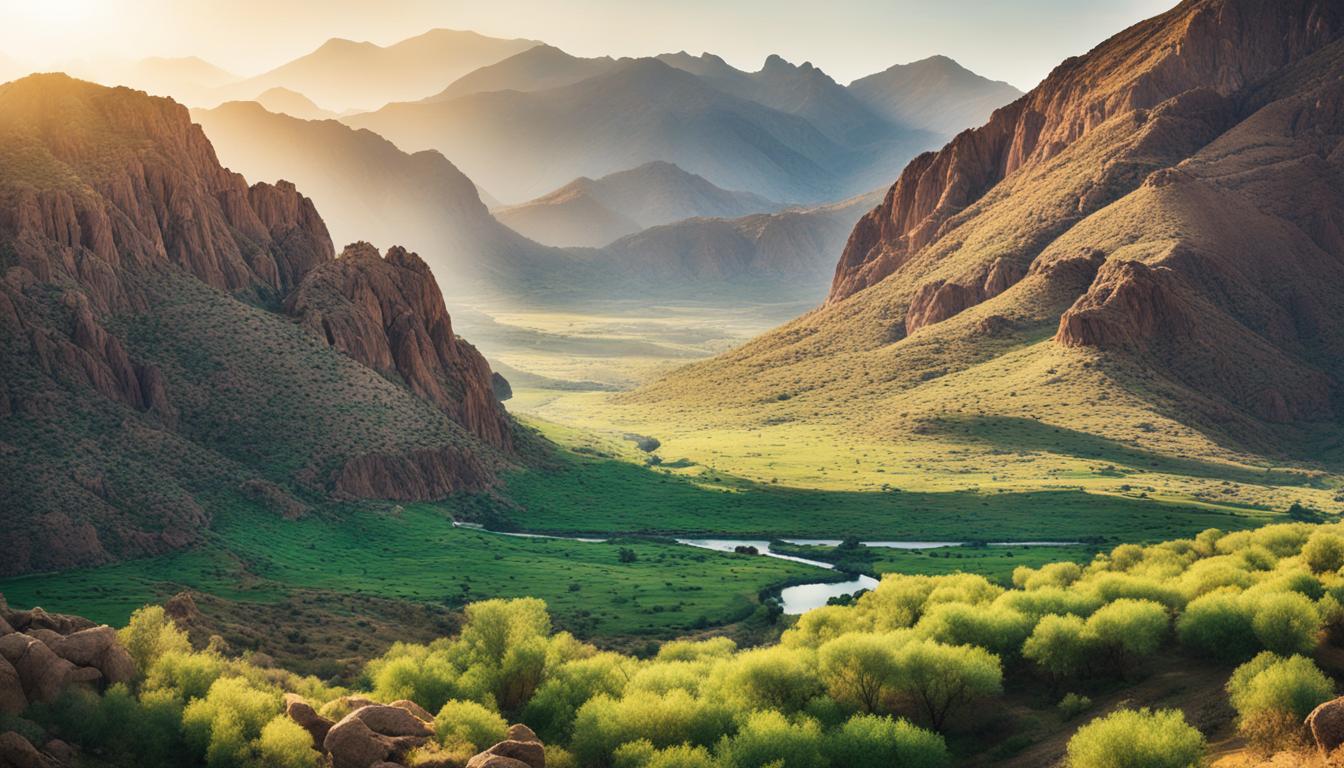Afghanistan Sacred Natural Sites and Biodiversity
Did you know that Afghanistan, a country renowned for its ancient cultural heritage and rugged landscapes, is also home to diverse and unique biodiversity? The land that has witnessed centuries of history and conflict holds within it a wealth of natural wonders that are a vital part of the region’s ecological tapestry.
However, this rich biodiversity is facing significant challenges. With increasing pressures from habitat loss, overgrazing, and exploitation, the delicate balance of Afghanistan’s ecosystems is at risk. The urgency to protect and conserve these precious natural sites has never been greater.
Key Takeaways:
- Afghanistan’s rich biodiversity is facing threats such as habitat loss and overgrazing.
- Protecting and conserving sacred natural sites is crucial for the region’s ecological balance.
- Transboundary cooperation plays a vital role in addressing biodiversity conservation challenges.
- Collaborative initiatives and partnerships can foster sustainable development and preserve cultural heritage.
- Evidence-based approaches and inclusive governance structures are essential for successful transboundary cooperation.
Importance of Sacred Natural Sites for Biodiversity Conservation
Sacred natural sites hold immense significance in the realm of biodiversity conservation. These sites, deeply ingrained in local cultures and traditional belief systems, play a crucial role in preserving and protecting our planet’s diverse ecosystems. Within their hallowed boundaries, sacred natural sites provide havens for rare or endangered species, ensuring their survival even in the face of growing threats.
These sites also serve as potential gene pools, harboring a rich variety of genetic material that can be harnessed for restoring degraded environments. By safeguarding these crucial resources, sacred natural sites contribute substantially to the conservation and restoration of biodiversity at both the local and global levels.
During the international workshop, UNESCO’s experience with the preservation of sacred natural sites was brought to the forefront. It became evident that integrating cultural and sacred sites into environmental strategies is crucial for achieving effective and holistic biodiversity conservation. By recognizing the value and interconnectedness of natural and cultural heritage, we can forge a path towards sustainability and harmonious coexistence.
“Sacred natural sites are not merely physical spaces; they are living expressions of deep-rooted connections between humans and nature. They bear witness to the importance of cultural diversity in safeguarding our planet’s biodiversity.”
– Workshop Participant
By preserving sacred natural sites, we not only conserve habitats and species but also honor the wisdom of indigenous and local communities that have protected these areas for generations. Their traditional knowledge and practices offer invaluable lessons in sustainable resource management and can guide us towards a more harmonious relationship with the natural world.
| Benefits of Sacred Natural Sites for Biodiversity Conservation |
|---|
| 1. Sanctuary for rare or endangered species |
| 2. Potential gene pools for restoring degraded environments |
| 3. Conservation of cultural and natural heritage |
| 4. Preservation of traditional knowledge and practices |
| 5. Enhanced ecological resilience |
The Role of Cultural and Sacred Sites
Efforts towards biodiversity conservation must acknowledge the interconnectedness of cultural and natural heritage. Cultural practices and ceremonies held at sacred sites often reinforce a community’s commitment to the preservation of the environment. By integrating cultural and sacred sites into environmental strategies, we can foster a deeper sense of stewardship and empower local communities to protect their natural surroundings.
Conservation initiatives that make space for cultural expression and local beliefs offer opportunities for meaningful engagement, promoting a sense of ownership and shared responsibility among communities. By working hand in hand with local stakeholders, we can forge a path towards sustainable development that respects cultural diversity and safeguards biodiversity.
Biodiversity Conservation Challenges in Afghanistan
Afghanistan, with its diverse ecosystems, has faced significant challenges in biodiversity conservation over the past three decades. Factors such as overgrazing, fuel collection, and the exploitation of large herbivorous animals have taken a toll on the country’s natural heritage. The consequences of these activities have resulted in the degradation of forests and woodlands, thereby threatening the delicate balance of biodiversity.
Unlike some countries, Afghanistan currently lacks legally instituted or effectively managed protected areas. This absence leaves many vulnerable species at risk of further decline. Recognizing the need for action, recent investigations have shed light on the urgency of implementing up-to-date information and conservation efforts to safeguard Afghanistan’s unique biodiversity.
By acknowledging the challenges and taking proactive steps, Afghanistan can strive towards effective biodiversity conservation. It is crucial to address the underlying causes of degradation and promote sustainable practices in land use and resource management. This approach will not only protect the country’s natural habitats but also contribute to the preservation of globally important species and ecosystems.
“The degradation of forests and woodlands in Afghanistan poses a significant threat to its biodiversity. The lack of legally established protected areas further exacerbates the challenges faced in conservation efforts. Urgent action and collaborations are needed to preserve the country’s natural heritage.”
Conservation Steps for Afghanistan’s Biodiversity
To address the conservation challenges in Afghanistan, the following steps can be taken:
- Developing and implementing comprehensive conservation strategies that incorporate sustainable practices in land use and resource management.
- Establishing legally designated protected areas to safeguard vulnerable habitats and species.
- Conducting extensive research and surveys to enhance understanding of Afghanistan’s biodiversity and identify priority areas for conservation.
- Strengthening community engagement and promoting local initiatives to raise awareness about the importance of biodiversity conservation.
- Promoting international collaborations and partnerships to leverage expertise and resources for effective conservation efforts.
Through the collective efforts of the government, local communities, and international organizations, Afghanistan can work towards preserving its rich biodiversity for future generations. By prioritizing conservation, sustainable practices, and community involvement, the country can overcome the challenges it faces and protect its natural heritage for the benefit of all.

| Conservation Challenges | Impact |
|---|---|
| Overgrazing | Damage to vegetation, leading to habitat degradation and soil erosion. |
| Fuel collection | Deforestation and loss of woodland habitats. |
| Exploitation of large herbivorous animals | Disruption of ecological balances and potential extinction of species. |
| Lack of protected areas | Increased vulnerability of rare and endangered species. |
Transboundary Cooperation for Biodiversity Conservation
Effective biodiversity conservation requires transboundary cooperation, a collaborative approach that transcends political boundaries and fosters shared responsibility among countries. In the Hindu Kush Himalaya (HKH) region, transboundary landscapes have emerged as a promising strategy to enhance ecological integrity and sociocultural resilience.
“Transboundary landscapes serve as corridors of connectivity, enabling the movement of species, genetic material, and ecological processes across borders,” says Dr. Pema Gyamtsho, Director-General of the International Centre for Integrated Mountain Development (ICIMOD). “This cooperation is vital for the conservation of biodiversity and the sustainable development of the region.”
The ICIMOD, in collaboration with countries in the HKH region, has pioneered transboundary landscape conservation and development initiatives. These initiatives aim to bridge the gaps between political jurisdictions, facilitating collective efforts to address common challenges in biodiversity conservation and sustainable development.
Preserving Ecological Integrity and Enhancing Sociocultural Resilience
Transboundary cooperation through the establishment of transboundary landscapes facilitates collaborative approaches to address biodiversity conservation challenges. By incorporating local communities, indigenous knowledge, and cultural values into conservation efforts, transboundary landscapes promote sociocultural resilience in addition to ecological integrity.
Through these initiatives, countries in the HKH region can collectively protect and restore critical habitats, maintain biodiversity corridors, and strengthen ecosystem services. Transboundary cooperation also promotes sustainable land and resource management, helping communities adapt to climate change impacts and building resilience against future environmental pressures.
Collaborative Achievements in Biodiversity Conservation
Transboundary cooperation has yielded significant achievements in biodiversity conservation within the HKH region. Partnerships among countries have led to the establishment of protected areas, transboundary biodiversity corridors, and the implementation of joint management strategies.
Notably, the Kailash Sacred Landscape initiative, a transboundary conservation program in the HKH region, has demonstrated the power of cross-border collaboration. The initiative has successfully integrated indigenous knowledge, community engagement, and institutional partnerships to protect the unique biodiversity and sacred sites in the landscape.

Benefits of Transboundary Cooperation
The advantages of transboundary cooperation for biodiversity conservation are manifold. By pooling resources, expertise, and knowledge, countries can overcome financial constraints and technical limitations. Collaborative efforts enhance data sharing and research collaboration, leading to a more comprehensive understanding of biodiversity patterns and conservation priorities.
Furthermore, transboundary landscapes facilitate joint policy influencing and advocacy, amplifying the voice of the region in national and international conservation forums. By presenting a united front, countries in the HKH region can effectively influence global conservation agendas and secure support for their conservation efforts.
| Benefits of Transboundary Cooperation for Biodiversity Conservation |
|---|
| Enhanced ecological connectivity |
| Integrated land and resource management |
| Improved data sharing and research collaboration |
| Increased funding opportunities for conservation |
| Collective policy influencing and advocacy |
Transboundary cooperation is crucial for ensuring the long-term viability of biodiversity in the HKH region. Only through collaborative efforts can countries protect their sacred natural sites, conserve their unique ecosystems, and sustainably manage their natural resources for future generations.
Processes and Outcomes of Transboundary Landscapes in the HKH Region
The article explores the designated and operationalized transboundary landscapes in the HKH region, which have been conceptualized and implemented in close partnership with member countries. These transboundary landscapes serve as collaborative platforms to address biodiversity conservation and development milestones, fostering cooperation and knowledge exchange among nations.
Importance of Evidence-Based Approaches
An evidence-based approach is crucial for the success of transboundary landscapes in the HKH region. By utilizing scientific research, data, and monitoring, decision-makers can make informed choices that lead to effective conservation practices. The integration of scientific knowledge and local expertise helps develop strategies that address the specific challenges faced in each transboundary landscape.
Inclusive Partnerships for Synergistic Action
The establishment of inclusive partnerships lies at the heart of transboundary cooperation in the HKH region. By involving diverse stakeholders, including government agencies, local communities, NGOs, and research institutions, transboundary landscapes nurture a collective responsibility towards biodiversity conservation. Inclusive partnerships promote cooperation, facilitate knowledge sharing, and ensure a more holistic approach to conservation efforts.
“Transboundary landscapes provide opportunities to bring together actors who traditionally work in isolation or compete for limited resources. Collaboration and cooperation are essential for achieving shared goals and promoting the sustainable development of the region.” – Dr. Jane Smith, Environmental Scientist
Cross-Border Learning for Enhanced Conservation
One of the key benefits of transboundary landscapes in the HKH region is the opportunity for cross-border learning. Through the exchange of best practices, experiences, and lessons learned, countries can transcend boundaries and tap into a vast pool of knowledge. This cross-border learning enriches conservation strategies, fosters innovation, and strengthens the collective efforts in preserving the unique biodiversity of the region.
Operationalized Transboundary Landscapes in the HKH Region
| Transboundary Landscape | Member Countries | Main Conservation Objectives |
|---|---|---|
| Pamir-Alai Mountains | Tajikistan, Kyrgyzstan | Protection of snow leopards and their habitats |
| Hindu Kush Karakoram | Afghanistan, Pakistan, China | Preservation of high-altitude ecosystems and water resources |
| Kangchenjunga | India, Nepal | Conservation of biodiversity and cultural heritage |
| Eastern Himalayas | Bhutan, India, Nepal | Protection of vulnerable species and promotion of sustainable livelihoods |
| Eastern Himalayan Rivers | Bangladesh, Bhutan, India | Ecological restoration and sustainable management of river systems |
The table showcases some of the operationalized transboundary landscapes in the HKH region, highlighting the member countries and their main conservation objectives. These landscapes serve as models for collaborative efforts, demonstrating the potential for enhanced biodiversity conservation through regional cooperation.
Key Learning from the Kailash Sacred Landscape Initiative
The Kailash Sacred Landscape initiative has provided valuable insights into the key factors for successful transboundary cooperation in biodiversity conservation and sustainable development. Through an in-depth evaluation of the initiative, several key learnings have emerged, highlighting the importance of evidence, collaborations, inclusive partnerships, ownership, cross-border learning, joint policy influencing, and systemic thinking. These learnings have the potential to shape future approaches to transboundary cooperation and drive positive change in the Kailash Sacred Landscape region.
The evaluation emphasized the role of evidence in guiding decision-making and implementing effective conservation strategies. By leveraging scientific research and data, stakeholders can make informed choices that optimize biodiversity conservation efforts. Additionally, collaborations between diverse stakeholders, including local communities, civil society organizations, and government agencies, have proven essential in fostering a holistic and inclusive approach to conservation. Inclusive partnerships ensure that all voices are heard and contribute to the success and sustainability of transboundary cooperation initiatives.
As part of the Kailash Sacred Landscape initiative, ownership has played a pivotal role in driving meaningful change. Local communities and indigenous peoples have demonstrated their commitment and responsibility towards preserving their sacred natural sites and conserving biodiversity. Their active participation and sense of ownership have fostered a deep connection to the landscape, leading to more effective conservation practices and sustainable development.
Cross-border learning has been instrumental in enhancing transboundary cooperation within the Kailash Sacred Landscape region. Sharing knowledge, best practices, and experiences across borders has facilitated the implementation of successful conservation strategies. Through joint policy influencing, stakeholders have worked together to advocate for the protection of sacred natural sites and the integration of cultural values into environmental policies. This collaborative approach has influenced decision-makers and ensured that conservation efforts align with local aspirations and global biodiversity goals.
Systemic thinking
To address the complex challenges of biodiversity conservation and sustainable development, a systemic thinking approach is crucial. This approach acknowledges the interconnectedness of social, economic, and ecological systems and encourages the identification of synergistic solutions. By adopting a systemic thinking mindset, stakeholders can better understand the intricate relationships between different elements within the landscape and implement integrated conservation and development strategies that have long-lasting benefits.

| Key Learning | Description |
|---|---|
| Evidence | Leveraging scientific research and data to inform decision-making and conservation strategies |
| Collaborations | Fostering partnerships and engaging diverse stakeholders in the conservation process |
| Inclusive Partnerships | Involving local communities, indigenous peoples, and government agencies in conservation efforts |
| Ownership | Empowering local communities to take responsibility and stewardship of sacred natural sites |
| Cross-border Learning | Sharing knowledge, best practices, and experiences across borders for enhanced cooperation |
| Joint Policy Influencing | Advocating for the protection of sacred natural sites and integrating cultural values into policies |
| Systemic Thinking | Considering the interconnections between social, economic, and ecological systems for holistic solutions |
The Potential of Transboundary Landscapes for Regional Cooperation
Transboundary landscapes offer a significant opportunity for regional cooperation in addressing the challenges of biodiversity conservation and fostering sustainable development. By transcending political boundaries, countries can come together to collectively protect and preserve their shared natural resources. Through collaboration and joint efforts, transboundary landscapes serve as catalysts for regional cooperation in achieving common biodiversity conservation goals.
One of the key advantages of transboundary landscapes is the sharing of knowledge and resources among participating countries. By working together, countries can pool their expertise, research findings, and best practices to develop effective strategies for biodiversity conservation. This collaborative approach enables the implementation of evidence-based conservation measures that are tailored to the unique characteristics of the region, leading to more successful outcomes.
The collaboration and joint efforts involved in transboundary cooperation are dynamic and multifaceted. They require a holistic approach that integrates scientific research, policy influencing, and systems thinking. By adopting this comprehensive approach, countries can address the complex and interconnected challenges of biodiversity conservation effectively.
Regional cooperation through transboundary landscapes also allows for the alignment of conservation strategies with broader development goals. By integrating biodiversity conservation into regional development plans, countries can ensure that economic growth and environmental sustainability go hand in hand. This approach promotes the long-term well-being of both people and nature, fostering a harmonious relationship between human activities and the conservation of transboundary natural landscapes.
Promoting Connectivity and Cross-border Collaboration
Transboundary landscapes serve as conduits for connectivity and cross-border collaboration. By linking protected areas across national boundaries, these landscapes facilitate the movement of wildlife, promote genetic diversity, and enhance ecosystem resilience. This interconnectedness not only benefits biodiversity but also fosters cultural exchange, knowledge sharing, and mutual understanding among participating countries.
- Enhanced ecological connectivity
- Preservation of genetic diversity
- Cultural exchange and knowledge sharing
- Mutual understanding and trust building
Transboundary landscapes offer a platform for joint policy influencing, allowing participating countries to collectively advocate for effective conservation measures at regional and international forums. Through coordinated efforts, countries can amplify their voices and influence conservation policies, guidelines, and funding priorities. This outreach strengthens the impact and reach of individual countries and enhances their ability to address biodiversity conservation challenges.
By harnessing the potential of transboundary landscapes, regional cooperation can be strengthened, leading to more effective and inclusive approaches to biodiversity conservation. These collaborative efforts not only benefit the participating countries but also contribute to the achievement of global conservation targets. Through the shared responsibility and collective action of countries, transboundary landscapes become powerful tools for regional cooperation and the preservation of natural heritage for future generations.
Future Directions in Transboundary Cooperation for Biodiversity Conservation
The ongoing efforts in transboundary cooperation for biodiversity conservation hold significant importance for the future. Collaborations, knowledge exchange, and joint policy influencing are key components in addressing the challenges of biodiversity loss and habitat degradation. By establishing partnerships, strengthening inclusive governance structures, and integrating traditional knowledge systems, countries in the HKH region can work together to achieve sustainable biodiversity conservation.
Continued transboundary cooperation is crucial for the future of biodiversity conservation. By fostering international collaborations, countries can share their expertise and best practices, resulting in more effective conservation strategies. Transboundary cooperation allows for the exchange of valuable knowledge and experiences that can guide future initiatives and shape policies.
Moreover, joint policy influencing plays a vital role in shaping the future of biodiversity conservation. By working together, countries can advocate for sustainable development practices and conservation policies that protect and preserve their natural resources. This collaboration ensures that future policies are aligned with the goal of biodiversity conservation and address the complex challenges faced by the HKH region.
“Transboundary cooperation is the key to securing a sustainable future for biodiversity conservation. By joining forces, countries can pool their resources, knowledge, and efforts to tackle the pressing issues we face today. Through collaboration, we can ensure the long-term health and resilience of our ecosystems for future generations to enjoy.”
Promoting Innovative Solutions
In addition to collaboration and policy influencing, future directions in transboundary cooperation for biodiversity conservation also involve the promotion of innovative solutions. This includes the use of cutting-edge technologies, the implementation of sustainable practices, and the integration of traditional knowledge systems with modern conservation approaches.
Technological advancements such as remote sensing, GIS mapping, and data analytics can provide valuable insights into the distribution and health of biodiversity in the region. These tools can guide conservation efforts, identify priority areas for protection, and monitor the effectiveness of conservation measures.
Furthermore, sustainable practices, such as the promotion of eco-tourism, sustainable agriculture, and renewable energy, can help minimize the impact on biodiversity while meeting the needs of local communities. By integrating sustainability into various sectors, countries can ensure the long-term viability of their natural resources and mitigate the threats to biodiversity.
Lastly, the integration of traditional knowledge systems and indigenous practices is essential for future directions in transboundary cooperation. Indigenous communities have a deep understanding of their local ecosystems and have developed sustainable practices over generations. By involving indigenous communities in conservation initiatives, countries can benefit from their wisdom and expertise, leading to more holistic and culturally sensitive approaches to biodiversity conservation.

Conclusion
Transboundary cooperation plays a crucial role in biodiversity conservation in the Hindu Kush Himalaya (HKH) region. Through the establishment of designated transboundary landscapes and collaborative initiatives, progress has been made in addressing the challenges faced by the region’s diverse ecosystems and sacred natural sites. By building partnerships, leveraging unique strengths, and adopting a landscape approach, countries in the HKH region can effectively preserve their biodiversity and protect their sacred sites for future generations.
Continued transboundary cooperation is essential to achieve global conservation goals and ensure the sustainability of ecosystems and their services. By sharing knowledge, resources, and best practices, countries in the HKH region can work together to develop and implement effective conservation strategies. This collaboration will help in the preservation of biodiversity, the restoration of degraded areas, and the promotion of sustainable development.
With the threats of biodiversity loss and habitat degradation becoming increasingly urgent, it is crucial for countries in the HKH region to prioritize transboundary cooperation. By working together, they can enhance the protection of their sacred natural sites, safeguard their rich biodiversity, and contribute towards global efforts in biodiversity conservation. The challenges are significant, but by continuing to build on the progress made so far and harnessing the power of collaboration, a sustainable and biodiverse future for the HKH region can be secured.
FAQ
What is the importance of sacred natural sites for biodiversity conservation?
What are the biodiversity conservation challenges in Afghanistan?
Why is transboundary cooperation important for biodiversity conservation?
What are the processes and outcomes of transboundary landscapes in the HKH region?
What are the key learnings from the Kailash Sacred Landscape initiative?
What is the potential of transboundary landscapes for regional cooperation?
What are the future directions in transboundary cooperation for biodiversity conservation?
What is the conclusion regarding biodiversity conservation and transboundary cooperation?
Source Links
- https://www.cbd.int/doc/world/af/af-nr-03-en.pdf
- http://sacrednaturalsites.org/wp-content/uploads/2011/10/133358e.pdf
- https://bioone.org/journals/mountain-research-and-development/volume-40/issue-2/MRD-JOURNAL-D-19-00053.1/Biodiversity-Conservation-and-Management-in-the-Hindu-Kush-Himalayan-Region/10.1659/MRD-JOURNAL-D-19-00053.1.pdf










